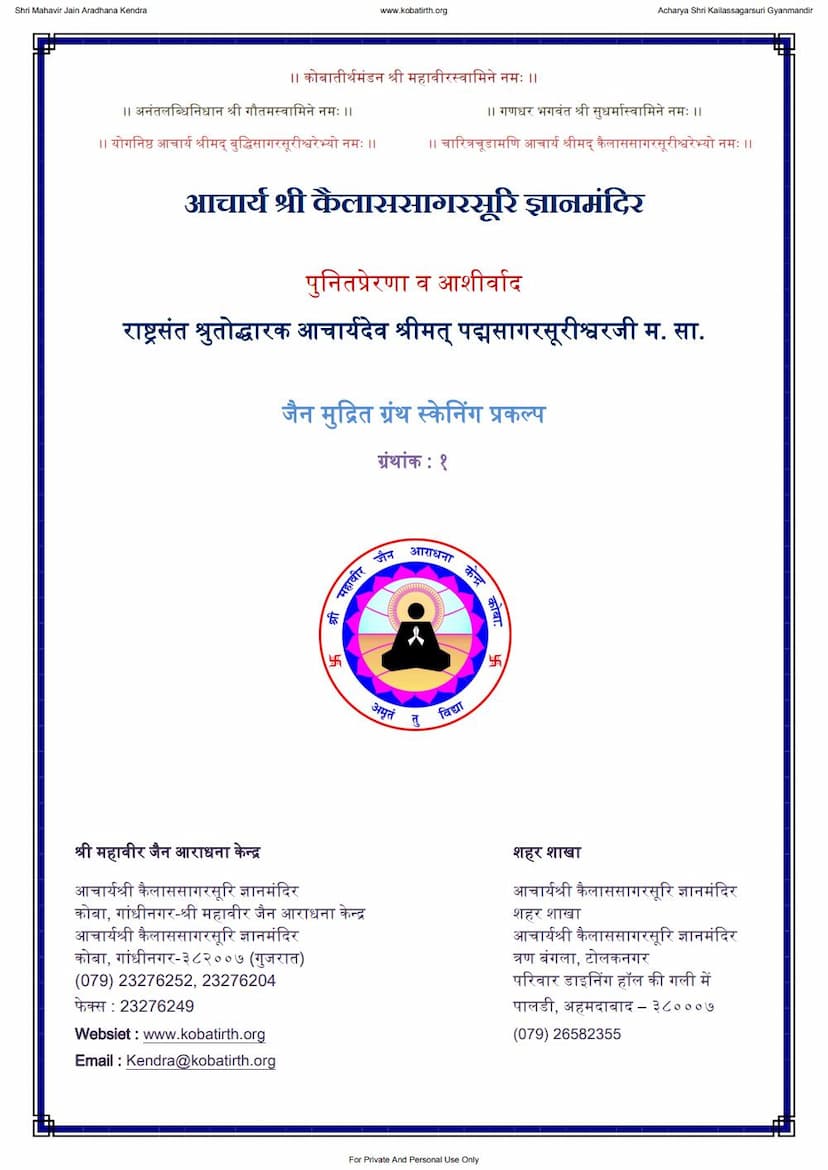Ashok Ane Ena Abhilekh
Added to library: September 1, 2025

Summary
Here's a comprehensive summary of the Jain text "Ashok Ane Ena Abhilekh" by Hariprasad Gangadhar Shastri, based on the provided text:
Book Title: Ashok Ane Ena Abhilekh (Ashoka and His Inscriptions) Author: Hariprasad Gangadhar Shastri Publisher: Gujarat University Publication Year: 1972
This book, published with the support of the University Grants Commission's Board for University Development, aims to provide a comprehensive introduction to Emperor Ashoka and his known inscriptions. The author emphasizes that while Buddhist traditions offer a narrative of Ashoka's transformation from a cruel ruler (Chandashoka) to a devout Buddhist (Dharmashoka) and highlight his contributions to the propagation of Buddhism, Ashoka's own inscriptions serve as more authentic and contemporary evidence of his reign and his profound adherence to Dharma.
Key Themes and Content:
- Ashoka's Life and Edicts: The book details Ashoka's lineage, his rise to power, his reign, the Kalinga War, his conversion to Buddhism, his family, and the chronology of his reign. It particularly focuses on how his inscriptions reveal his noble religious policy and discipline, offering a vivid and authenticated picture of this great monarch.
- The Significance of Inscriptions: Shastri highlights that Ashoka's inscriptions are invaluable primary sources for understanding his reign. While Buddhist traditions often have legendary elements and are written centuries later, the inscriptions are contemporary records that provide a more reliable basis for historical understanding.
- Ashoka's Contributions: Beyond his religious policies, Ashoka is acknowledged for his significant contributions to the contemporary languages, scripts, art, and architecture of India. However, his most precious and invaluable contribution is deemed to be his noble religious sentiment and his relentless enthusiasm for its propagation. The Dharma expressed in his inscriptions continues to convey a message of cultural advancement and universal welfare.
- Dating Ashoka: The book discusses the challenges and methods used to date Ashoka's reign and his inscriptions, referencing contemporary foreign rulers mentioned in his edicts (like Antiochus II, Ptolemy II, Antigonus Gonatus, Magas, and Alexander) to establish a timeframe, primarily around 258-255 BCE.
- Types of Inscriptions: Shastri meticulously categorizes Ashoka's inscriptions into four main types:
- Rock Edicts (Shilalekh): Divided into Fourteen Major Rock Edicts, two separate Kalinga Rock Edicts, and Minor Rock Edicts.
- Pillar Edicts (Stambh Lekh): Including Seven Major Pillar Edicts and Minor Pillar Edicts.
- Cave Inscriptions (Guha Lekh): Found in caves.
- Tablet Inscriptions (Phalak Lekh): Smaller stone inscriptions.
- Content of the Edicts: The summary provides a brief overview of the themes covered in the edicts, emphasizing their focus on:
- Prohibitions on animal sacrifice and public festivities involving cruelty.
- Measures for public welfare, including medical facilities, the digging of wells, and the planting of trees along routes.
- The appointment of Dharma Mahamatras to promote morality and welfare across all religious sects.
- The importance of religious tolerance and respect for all faiths, encouraging dialogue and understanding.
- The Kalinga Edict (Major Rock Edict XIII) stands out for Ashoka's remorse after the war and his declaration of a "Dharma Vijaya" (victory of righteousness) over military conquest.
- Ashoka's Administration and Philosophy: The book delves into Ashoka's administrative structure, mentioning officials like Kumaras (governors of provinces), Mahamatras (high-ranking officials), Yuktas, Rajjukas, and Pradesikas (officials responsible for administrative and judicial duties). It highlights his compassion towards all living beings, his emphasis on welfare measures, and his belief that ruling justly was a means to repay his debt to all creatures.
- Art and Architecture: Shastri discusses Ashoka's contributions to art and architecture, particularly his monumental stone pillars with their intricately carved capitals, which are considered masterpieces of ancient Indian sculpture. He also touches upon his role in building stupas, viharas, and cave dwellings for ascetics.
- Linguistic and Epigraphic Analysis: The book provides a detailed analysis of the Brahmi and Kharosthi scripts used in Ashoka's inscriptions, as well as the Prakrit language, noting regional variations and the linguistic significance of these records.
- Ashoka's Legacy: The author concludes by placing Ashoka in the context of world history, comparing him to figures like Constantine and Marcus Aurelius, but ultimately highlighting Ashoka's unique contribution to promoting a universal humanistic Dharma rather than a specific religious doctrine for political gain. His enduring legacy lies in his unwavering commitment to ethical governance and the propagation of a moral code for the welfare of all beings, a message that resonates even today.
In essence, "Ashok Ane Ena Abhilekh" serves as a scholarly yet accessible guide to understanding Emperor Ashoka, not just through the lens of Buddhist narratives, but primarily through the direct, contemporary evidence of his inscriptions, revealing his profound thoughts on governance, welfare, and universal peace.